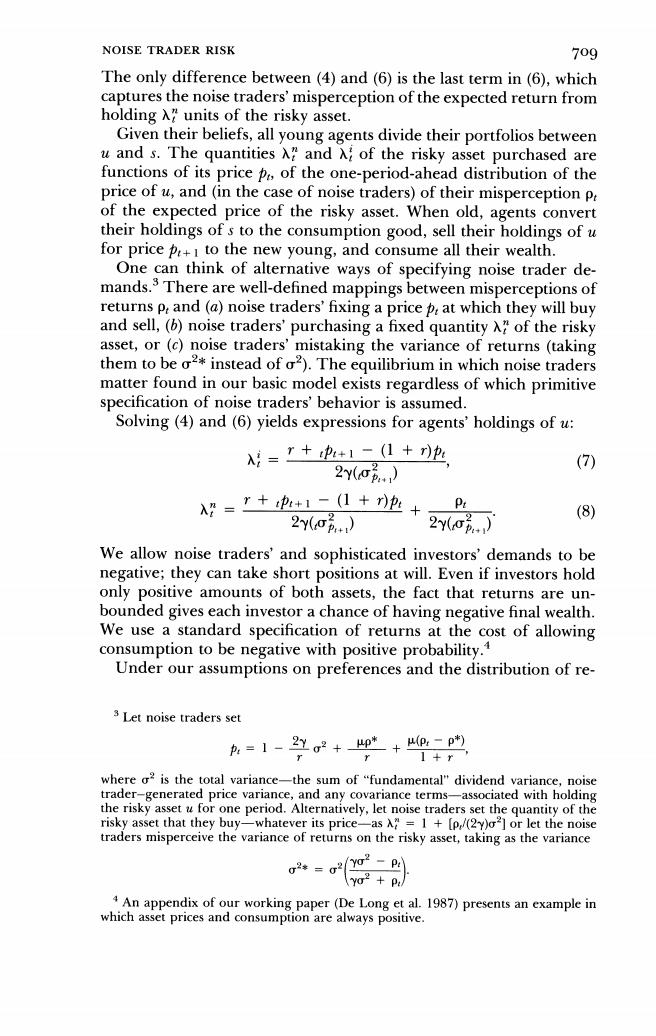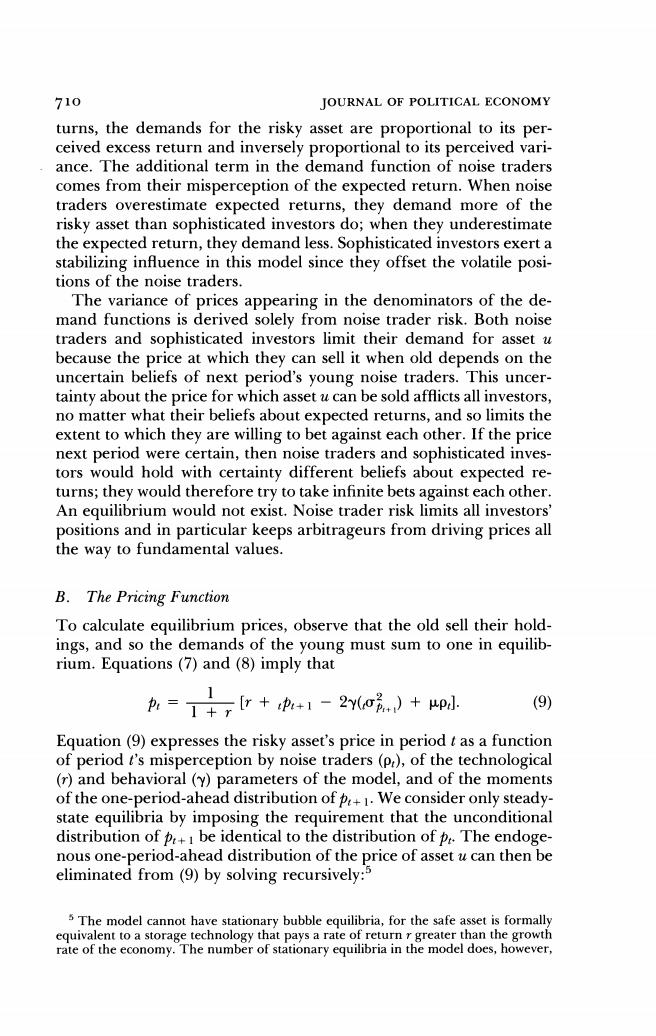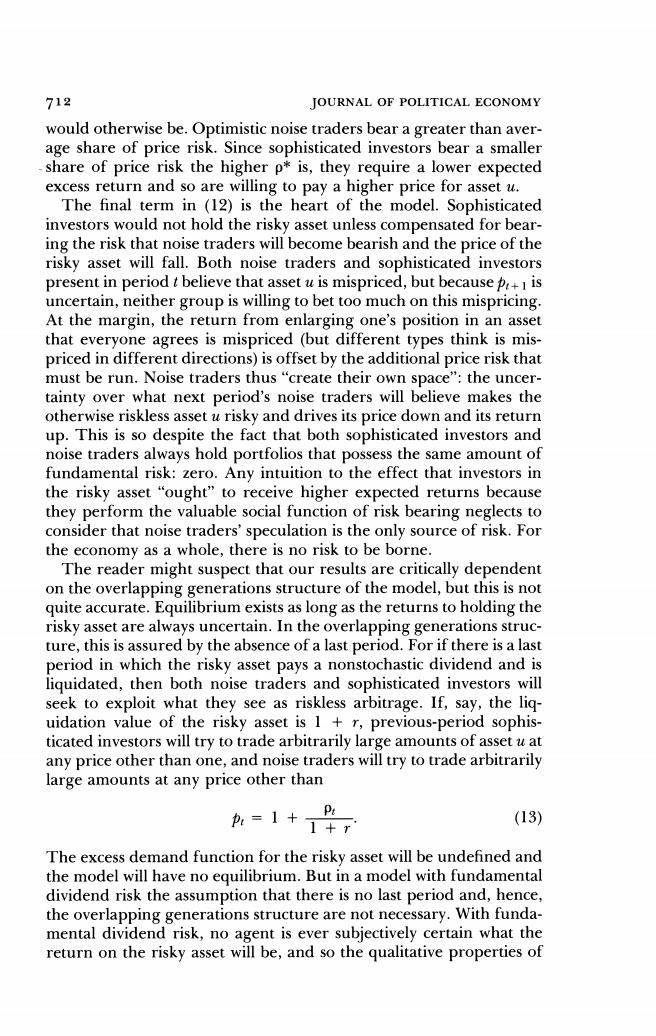
708 JOURNAL OF POLITICAL ECONOMY period t accurately perceives the distribution of returns from holding the risky asset,and so maximizes expected utility given that distribu- tion.The representative noise trader young in period t misperceives the expected price of the risky asset by an independent and identically distributed normal random variable p: p~N(p*,σ). (1) The mean misperception p*is a measure of the average"bullishness" of the noise traders,and o is the variance of noise traders'mispercep- tions of the expected return per unit of the risky asset.?Noise traders thus maximize their own expectation of utility given the next-period dividend,the one-period variance of,and their false belief that the distribution of the price of u next period has mean p above its true value. Each agent's utility is a constant absolute risk aversion function of wealth when old: U=-e-(2y)w. (2) where y is the coefficient of absolute risk aversion.With normally distributed returns to holding a unit of the risky asset,maximizing the expected value of(2)is equivalent to maximizing 而-yo2, (3) where w is the expected final wealth,and o is the one-period-ahead variance of wealth.The sophisticated investor chooses the amountA of the risky asset u held to maximize E(U)=w-yo (4) =c0+入r+p+1-p1+]-y2(oa., where co is a function of first-period labor income,an anterior sub- script denotes the time at which an expectation is taken,and we define o,=Ep+1-Ep+]門 (5) to be the one-period variance of p+1.The representative noise trader maximizes E(U)=而-yσ品 (6) =c0+入[r+p+1-(1+]-y入)(o)+入2(p) 2 The assumption that noise traders misperceive the expected price hides the fact that the expected price is itself a function of the parameters p*and o Thus we are implicitly assuming that noise traders know how to factor the effect of future price volatility into their calculations of values.This assumption is made for simplicity.We have also solved a more complicated model that parameterizes noise traders'beliefs by their expectations of future prices,not by their misperceptions of future returns.The thrust of the results is the same

NOISE TRADER RISK 709 The only difference between(4)and(6)is the last term in(6),which captures the noise traders'misperception of the expected return from holding A"units of the risky asset. Given their beliefs,all young agents divide their portfolios between u and s.The quantities A and of the risky asset purchased are functions of its price pa,of the one-period-ahead distribution of the price of u,and(in the case of noise traders)of their misperception pe of the expected price of the risky asset.When old,agents convert their holdings of s to the consumption good,sell their holdings of u for pricep+I to the new young,and consume all their wealth. One can think of alternative ways of specifying noise trader de- mands.3 There are well-defined mappings between misperceptions of returns p and(a)noise traders'fixing a price p at which they will buy and sell,(b)noise traders'purchasing a fixed quantity A"of the risky asset,or (c)noise traders'mistaking the variance of returns (taking them to be o2*instead of o2).The equilibrium in which noise traders matter found in our basic model exists regardless of which primitive specification of noise traders'behavior is assumed. Solving(4)and(6)yields expressions for agents'holdings of u: x=T++1-((1+p (7) 2y(o.) N=+0+地+ P (8) 2yo.) 2() We allow noise traders'and sophisticated investors'demands to be negative;they can take short positions at will.Even if investors hold only positive amounts of both assets,the fact that returns are un- bounded gives each investor a chance of having negative final wealth. We use a standard specification of returns at the cost of allowing consumption to be negative with positive probability.4 Under our assumptions on preferences and the distribution of re- 3 Let noise traders set p:=1-2Yg2+p*+®-p 1+r where o2 is the total variance-the sum of "fundamental"dividend variance,noise trader-generated price variance,and any covariance terms-associated with holding the risky asset u for one period.Alternatively,let noise traders set the quantity of the risky asset that they buy-whatever its price-asA=1 [p/(2y)o2]or let the noise traders misperceive the variance of returns on the risky asset,taking as the variance 2*=g2Y02-p4 yo2 pr 4 An appendix of our working paper(De Long et al.1987)presents an example in which asset prices and consumption are always positive

710 JOURNAL OF POLITICAL ECONOMY turns,the demands for the risky asset are proportional to its per- ceived excess return and inversely proportional to its perceived vari- ance.The additional term in the demand function of noise traders comes from their misperception of the expected return.When noise traders overestimate expected returns,they demand more of the risky asset than sophisticated investors do;when they underestimate the expected return,they demand less.Sophisticated investors exert a stabilizing influence in this model since they offset the volatile posi- tions of the noise traders. The variance of prices appearing in the denominators of the de- mand functions is derived solely from noise trader risk.Both noise traders and sophisticated investors limit their demand for asset u because the price at which they can sell it when old depends on the uncertain beliefs of next period's young noise traders.This uncer- tainty about the price for which asset u can be sold afflicts all investors, no matter what their beliefs about expected returns,and so limits the extent to which they are willing to bet against each other.If the price next period were certain,then noise traders and sophisticated inves- tors would hold with certainty different beliefs about expected re- turns;they would therefore try to take infinite bets against each other. An equilibrium would not exist.Noise trader risk limits all investors' positions and in particular keeps arbitrageurs from driving prices all the way to fundamental values. B.The Pricing Function To calculate equilibrium prices,observe that the old sell their hold- ings,and so the demands of the young must sum to one in equilib- rium.Equations(7)and(8)imply that A=+,+A1-2)+pl (9) Equation(9)expresses the risky asset's price in period t as a function of period t's misperception by noise traders(P),of the technological (r)and behavioral(Y)parameters of the model,and of the moments of the one-period-ahead distribution ofp+1.We consider only steady- state equilibria by imposing the requirement that the unconditional distribution of+be identical to the distribution ofp The endoge- nous one-period-ahead distribution of the price of asset u can then be eliminated from(9)by solving recursively: s The model cannot have stationary bubble equilibria,for the safe asset is formally equivalent to a storage technology that pays a rate of return r greater than the growth rate of the economy.The number of stationary equilibria in the model does,however

NOISE TRADER RISK 711 办=1+的+p-2(o (10) 1+r Inspection of(10)reveals that only the second term is variable,for y, p*,and r are all constants,and the one-step-ahead variance of is a simple unchanging function of the constant variance of a generation of noise traders'misperception Pe: 乐吸 (11) The final form of the pricing rule for u,in which the price depends only on exogenous parameters of the model and on public informa- tion about present and future misperception by noise traders,is ,=1+p,-p+p*-2Yμ2o r1+r)2 (12) 1+m C.Interpretation The last three terms that appear in(12)and(10)show the impact of noise traders on the price of asset u.As the distribution of p,con- verges to a point mass at zero,the equilibrium pricing function(12) converges to its fundamental value of one. The second term in(12)captures the fluctuations in the price of the risky asset u due to the variation of noise traders'misperceptions Even though asset u is not subject to any fundamental uncertainty and is so known by a large class of investors,its price varies substantially as noise traders'opinions shift.When a generation of noise traders is more bullish than the average generation,they bid up the price of u. When they are more bearish than average,they bid down the price. When they hold their average misperception-when pa=p*-the term is zero.As one would expect,the more numerous noise traders are relative to sophisticated investors,the more volatile asset prices are. The third term in(12)captures the deviations ofp from its funda- mental value due to the fact that the average misperception by noise traders is not zero.If noise traders are bullish on average,this "price pressure"effect makes the price of the risky asset higher than it depend on the primitive specification of noise traders'behavior.For example,if noise traders randomly pick each period the price p at which they will buy and sell unlimited quantities of the risky asset,then(trivially)there is only one equilibrium.If the noise traders randomly pick the quantitythat they purchase,then the fundamental solu- tion in whichp,is always equal to one is an equilibrium in addition to the equilibrium in which noise traders matter

712 JOURNAL OF POLITICAL ECONOMY would otherwise be.Optimistic noise traders bear a greater than aver- age share of price risk.Since sophisticated investors bear a smaller share of price risk the higher p*is,they require a lower expected excess return and so are willing to pay a higher price for asset u. The final term in (12)is the heart of the model.Sophisticated investors would not hold the risky asset unless compensated for bear- ing the risk that noise traders will become bearish and the price of the risky asset will fall.Both noise traders and sophisticated investors present in periodtbelieve that asset u is mispriced,but becausepis uncertain,neither group is willing to bet too much on this mispricing. At the margin,the return from enlarging one's position in an asset that everyone agrees is mispriced (but different types think is mis- priced in different directions)is offset by the additional price risk that must be run.Noise traders thus "create their own space":the uncer- tainty over what next period's noise traders will believe makes the otherwise riskless asset u risky and drives its price down and its return up.This is so despite the fact that both sophisticated investors and noise traders always hold portfolios that possess the same amount of fundamental risk:zero.Any intuition to the effect that investors in the risky asset "ought"to receive higher expected returns because they perform the valuable social function of risk bearing neglects to consider that noise traders'speculation is the only source of risk.For the economy as a whole,there is no risk to be borne. The reader might suspect that our results are critically dependent on the overlapping generations structure of the model,but this is not quite accurate.Equilibrium exists as long as the returns to holding the risky asset are always uncertain.In the overlapping generations struc- ture,this is assured by the absence of a last period.For if there is a last period in which the risky asset pays a nonstochastic dividend and is liquidated,then both noise traders and sophisticated investors will seek to exploit what they see as riskless arbitrage.If,say,the liq- uidation value of the risky asset is 1 r,previous-period sophis- ticated investors will try to trade arbitrarily large amounts of asset u at any price other than one,and noise traders will try to trade arbitrarily large amounts at any price other than A=1+, (13) The excess demand function for the risky asset will be undefined and the model will have no equilibrium.But in a model with fundamental dividend risk the assumption that there is no last period and,hence, the overlapping generations structure are not necessary.With funda- mental dividend risk,no agent is ever subjectively certain what the return on the risky asset will be,and so the qualitative properties of